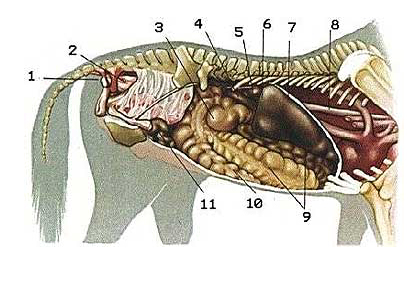(2) Rectum
(3) Base of caecum.
(4) Dunne darm.
(5) Nier.
(6) Lever.
(7) Diaphragma.
(8) Slokdarm.
(9) Dikke darm.
(10) Caecum.
(11) Small colon.
Caecum = Blinde darm

The anatomical peculiarities of the horse’s digestive system compared with other mammals are:
(i) that the greatest volume of the tract is in the hind end, namely the caecum, and colon, where the major process of digesting fibre occurs by bacterial fermentation
(ii) the relatively small stomach
(iii) the absence of a gall bladder (probably associated with the need for acontinual supply of bile in an animal which is a continuous feeder)
Voeding
Als een paard te gulzig (biks) eet; stro erdoor doen. Tegen het (kribbe)bijten Finalgon te gebruiken.
Spijsvertering
De spijsvertering moet rommelen; als je niks hoort met je oor tegen de zijkant van de buik van het paard, is het niet in orde.
-Oorspeekselklier: kan opzwellen en op droes lijken maar dat is het niet. Droes is een ontsteking van de lymfeklieren die begint in de keelholte. Door het paard aan de teugel te rijden kan de oorspeekselklier opzwellen en de luchtpijp dichtdrukken, waardoor het paard kan flauwvallen.
-Slokdarm: ligt links in de groeve van de keel naar de borst. Door te droog voer kan de slokdarm verstopt raken. Dit ziet er vreselijk uit. Het paard laten staan en een slang door de neus (onderste kanaal) naar binnen brengen om alles eruit te zuigen of om parafineolie (wordt niet verteerd) naar binnen te brengen.
-Maag: middelpunt van de romp. Veel te klein; ca 15 liter. Een paard kan niet braken; de maag kan openspringen bij overlading.
-Blinde darm: ligt helemaal los rechtsonder in de buikholte. Hier wordt ruwe celstof verteerd met behulp van micro-organismen. Daardoor ontstaat gasvorming, waardoor de buik opzwelt.
In de praktijk wordt de leeftijd van paarden geschat aan de hand van veranderingen in het gebit. Deze gebitsveranderingen zijn het gevolg van het doorkomen, het wisselen en de afslijting van de tanden, waarbij voor de schatting van de leeftijd vooral gebruik wordt gemaakt van de tanden in de onderkaak.
Gebit-Snijtanden-Lagen-Kiezen (totaal 44 stuks maximaal)
| Snijtanden | 2 binnenste | 2 middelste | 2 buitenste |
| wisselen na | 2,5 | 3,5 | 4,5 jaar |
| komen bij elkaar na | 3 | 4 | 5 jaar |
| Het duurt 3 jaar voordat alles gevuld is | 6 | 7 | 8 jaar, |
-aftands. Daarna groeit de buitenste snijtand (=hoektand) over: 9 jaar.
-Vanaf de bovenkant van de hoektand groeit er een donker groefje naar beneden: hoe lager hoe ouder.
-Haak: scherpe opstaande randen aan de kiezen, vooral de achterste.



